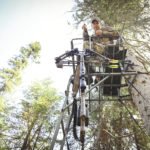All three species of flying squirrels in North America—northern, southern, and Humboldt’s flying squirrels—glow hot pink when illuminated by a black light flashlight.
When’s the last time something caught you so by surprise that your mouth gaped open a bit before you started laughing and shaking your head in disbelief? What last caused you to tilt your head back toward the sky, your gaze drifting off into the distance, while your heart swelled with some wordless feeling that the Earth is an amazing place to live?
For those of us who have the privilege to spend time experiencing and learning about nature, those feelings happen fairly frequently. Sometimes we make the observation firsthand, and sometimes it takes the hard work of scientists to reveal something new.
Last winter, science provided many of us with a healthy dose of amazement when a story about flying squirrels fluorescing pink in UV light went viral. First submitted to the Journal of Mammalogy, the story was soon picked up by the journal Nature, The New York Times, National Geographic, Newsweek, and Smithsonian. A team of professors and students from Northland College in Ashland, Wisc., made the discovery. All three species of flying squirrels in North America—northern, southern, and Humboldt’s flying squirrels—glow hot pink when illuminated by a black light flashlight.
Fluorescence isn’t all that uncommon in nature. We’ve known for years that spiders and scorpions fluoresce. The freshly grown feathers of some species of owls fluoresce pink, and bird researchers use the trait to determine their age. Various parts of puffins, parrots, penguins, corals, opossums, sea turtles, and fox squirrel bones all fluoresce as well.
What do those creatures have in common? Not much, except that when their exoskeletons, feathers, or skins absorb ultraviolet light—which is invisible to the human eye—the light that is subsequently emitted has a longer wavelength and now falls within the range that is visible to humans. For example, in UV light, flying squirrel bellies go from basic white to hot pink. This is different than the bioluminescence of fireflies, who produce light through a chemical reaction.
In 2017, the South American polka-dot tree frog was found to fluoresce with a blue and green glow. The study’s co-author, Julián Faivovich, thinks that more fluorescent frogs will be discovered, and was quoted saying, “I’m really hoping that other colleagues will be very interested in this phenomenon, and they will start carrying a UV flashlight to the field.”
Whether he read those words or not, the discovery piqued Jon Martin’s curiosity. Martin is an energetic, tree-climbing professor of forestry at Northland College, and after reading that research he just had to find out if the Northwoods’ own gray tree frogs might fluoresce as well. They don’t, he was disappointed to find, but it was still great fun to prowl around his backyard at night to see if anything else did.
“When the stars align and you find yourself in woods, with flying squirrels, with a black light in hand… it just makes sense to point the light in their direction,” said Martin.
Erik Olson, Northland’s wildlife professor, soon joined Martin at his backyard bird feeder. “It was pretty awesome,” remembered Olson, “not even to see it fluoresce, but just to watch the flying squirrel glide in with its dark shadow against the pale blue of a night sky. I love watching those guys gliding in to a feeder in winter. They are pretty fascinating animals on their own.”
Flying squirrels don’t actually fly, of course, but glide on a flap of skin, called a patagium. It stretches between their front and hind legs, and is held out wide by an extra bit of cartilage on their wrist called a styliform. These three-ounce acrobats can turn 90 degrees around an obstacle in the air. A flip of their thin, flat tail changes their trajectory upward for a smooth landing. Immediately after landing, the squirrel will run to the other side of the tree trunk, just in case a predator spotted it in the air.
Could those predators be one reason that squirrels glow pink? Small owls are one of these nocturnal mammals’ main predators, and it just so happens that owls’ bellies fluoresce in the same rosy shade. Might the squirrels be trying to disguise themselves as owls? Or is it some form of communication between the squirrels themselves? And, what causes the fluorescence, anyway?
While the initial observation prompted lots of questions, the first major step was to confirm the discovery in a scientific way. That’s where Allie Kohler, then entering her senior year at Northland, (and now working on a master’s degree at Texas A&M,) came in. Kohler had been part of Olson’s wildlife research lab since she’d transferred to Northland after her freshman year. She explained that, at her first college, “they were teaching me about nature from a textbook.” That just wouldn’t do for a curious, science-loving, Boundary Waters kid from Corcoran, Minn.
Olson and Martin share lab space at Northland, due to Olson’s conviction that “cross pollination can lead to great discoveries and advancement.” Professor Paula Anich spends time in their lab, too. Kohler had been doing small mammal trapping with Anich, so Martin gave Kohler his black light and asked her to take photos of the next flying squirrel she captured. She did. Soon she was leading the charge.
Kohler secured her own travel money through a professional development fund on campus, and an invitation to explore the collections of the Science Museum of Minnesota. After shining her light on almost 100 specimens of flying squirrels, she was confident that all of them—all three species and all across North America—fluoresced pink. The researchers later gathered even more confirmations at the Field Museum in Chicago.
“Allie did really amazing work,” said Anich. “She had a lot of insight and big ambitions. She worked extraordinarily hard.”
Martin, too, enjoyed involving a student in the cutting-edge research. “We were able to share the research process in its fullest with Allie, who represents the next generation of scientists, and each new scientist will have their own questions, solutions and energy.”
After the three professors guided Kohler through the scientific writing process, they submitted the article to the Journal of Mammalogy, with Kohler as lead author. Within a week, their research was accepted, published, and making headlines across the country.
“While all the news coverage was great,” Martin told me in an email, “I think the biggest reward is knowing that this newly discovered trait might inspire curiosity and conservation for the environment across all ages.”
Kohler concurs, adding that “This just shows that so much is hiding right in front of us. Many of us have flying squirrels in our backyard. If we just look at them in a different way, they can show us a whole new world.”
“Our northern forests are FULL of things we haven’t discovered yet,” added Anich.
It’s only a matter of time, then, before the next discovery catches us by surprise and reminds us that the Earth is an amazing place to live.






